coolant HYUNDAI SONATA 2023 Owners Manual
[x] Cancel search | Manufacturer: HYUNDAI, Model Year: 2023, Model line: SONATA, Model: HYUNDAI SONATA 2023Pages: 555, PDF Size: 42.72 MB
Page 19 of 555
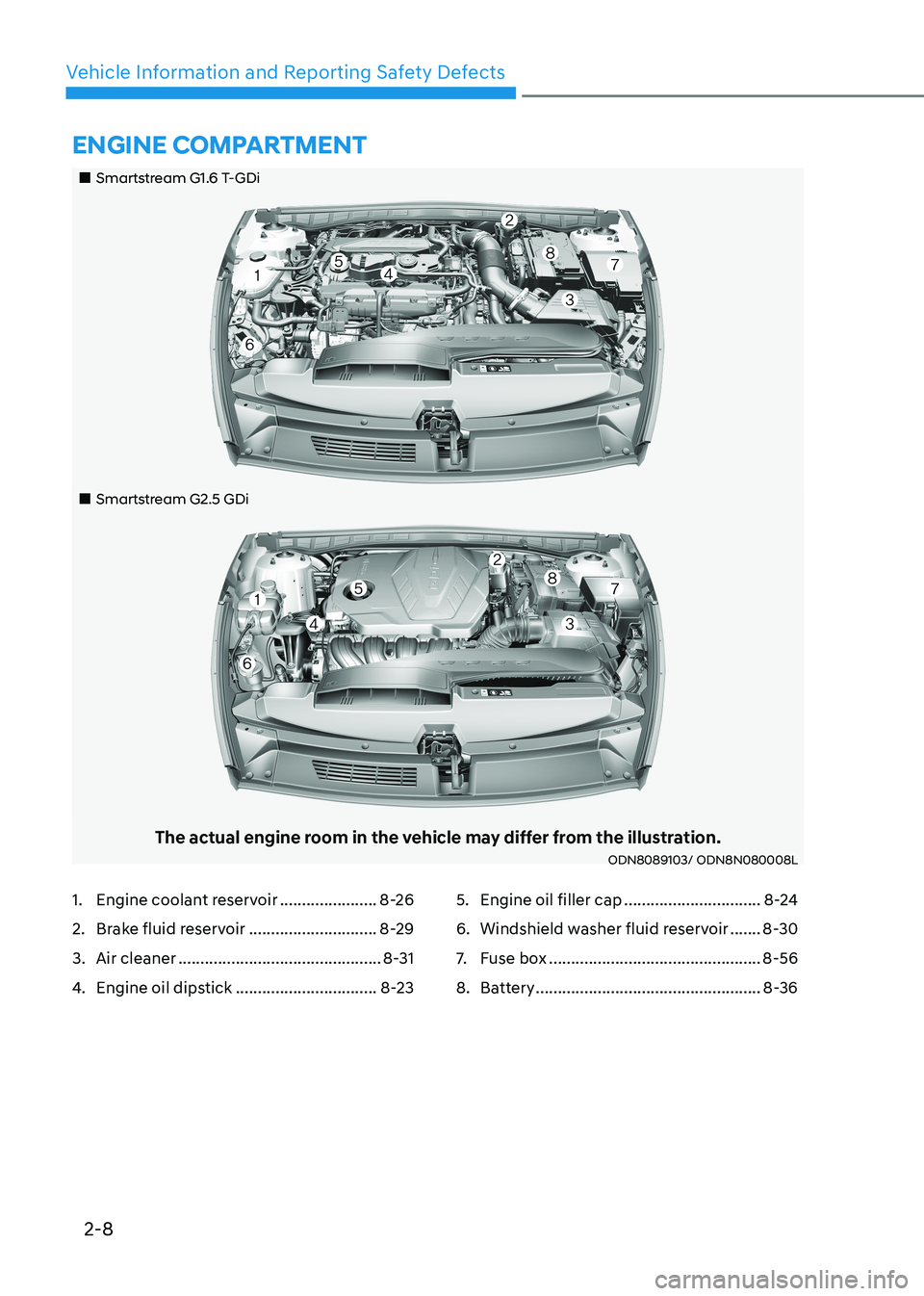
2-8
Vehicle Information and Reporting Safety Defects
„„Smartstream G1.6 T-GDi
„„Smartstream G2.5 GDi
The actual engine room in the vehicle may differ from the illustration.ODN8089103/ ODN8N080008L
EnginE ComPartmEnt
1. Engine coolant reservoir ......................8-26
2. Brake fluid reservoir .............................8-29
3. Air cleaner .............................................. 8-31
4. Engine oil dipstick ................................ 8-235. Engine oil filler cap
...............................8-24
6. Windshield washer fluid reservoir .......8-30
7. Fuse box ................................................ 8-56
8. Battery ................................................... 8-36
Page 20 of 555
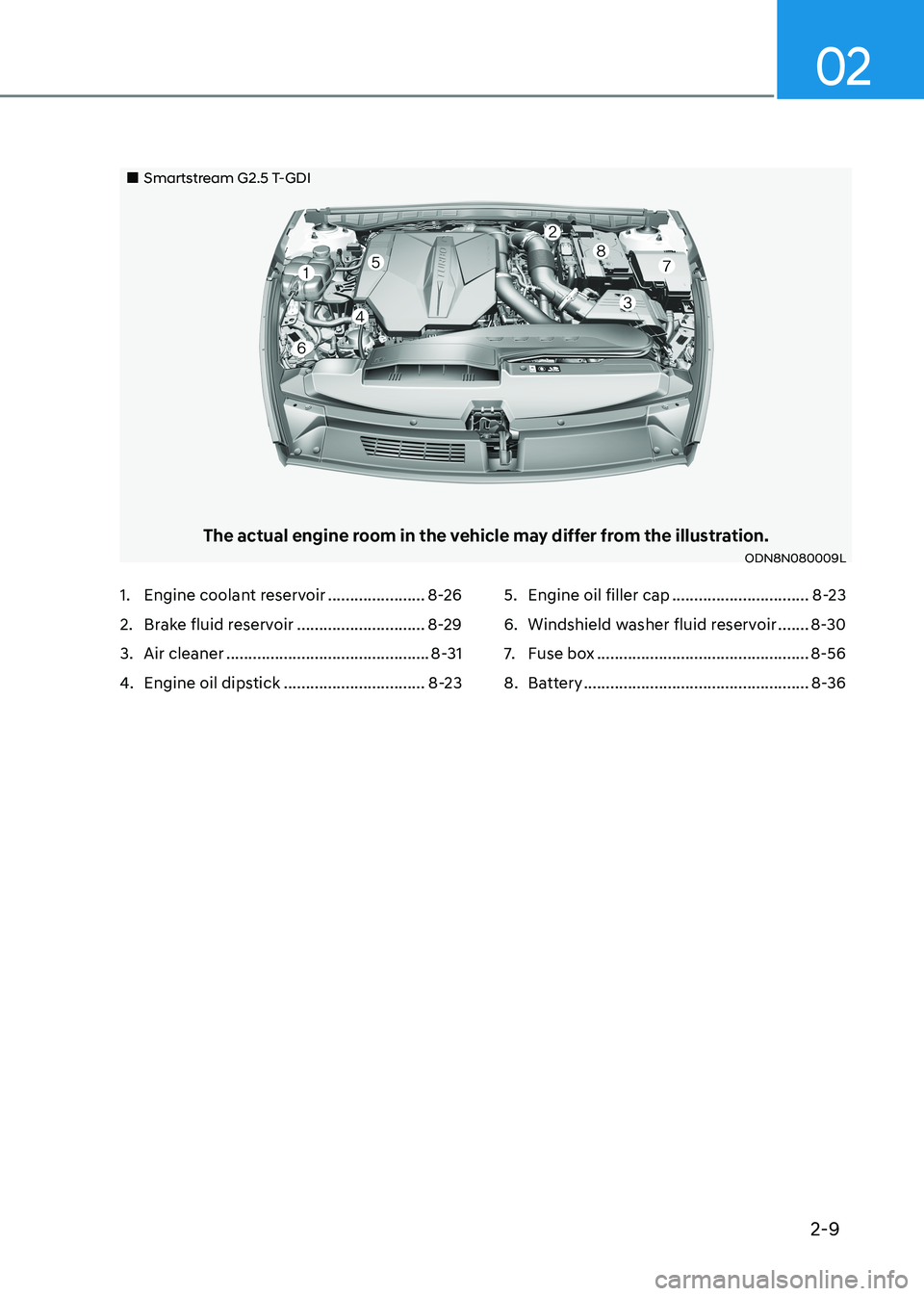
2-9
02
„„Smartstream G2.5 T-GDI
The actual engine room in the vehicle may differ from the illustration.ODN8N080009L
1. Engine coolant reservoir ......................8-26
2. Brake fluid reservoir .............................8-29
3. Air cleaner .............................................. 8-31
4. Engine oil dipstick ................................ 8-235. Engine oil filler cap
...............................8-23
6. Windshield washer fluid reservoir .......8-30
7. Fuse box ................................................ 8-56
8. Battery ................................................... 8-36
Page 25 of 555
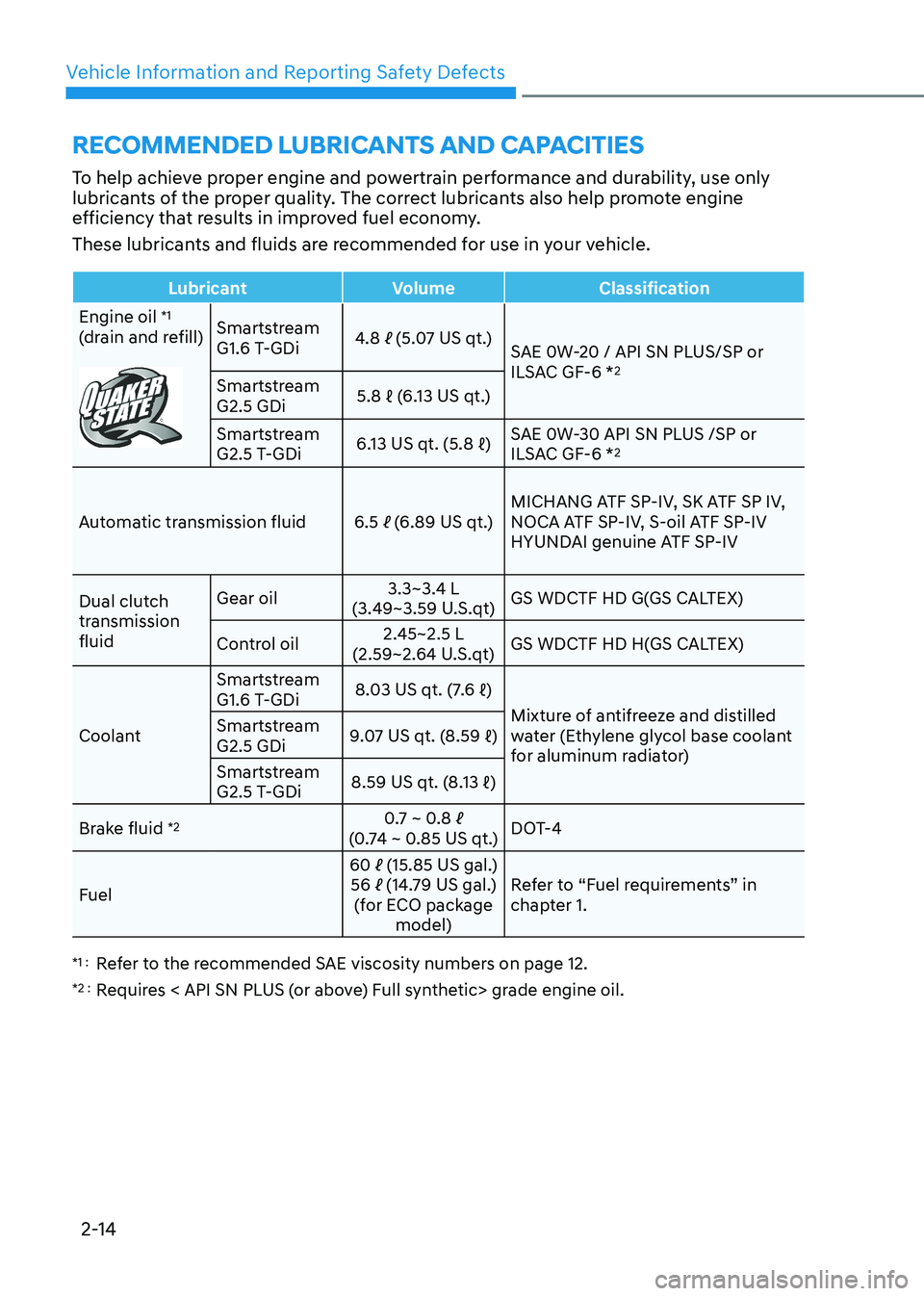
Vehicle Information and Reporting Safety Defects
2-14
rECommEnDED luBriCants anD CaPaCitiEs
To help achieve proper engine and powertrain performance and durability, use only
lubricants of the proper quality. The correct lubricants also help promote engine
efficiency that results in improved fuel economy.
These lubricants and fluids are recommended for use in your vehicle.
Lubricant Volume Classification
Engine oil *1
(drain and refill) Smartstream
G1.6 T-GDi 4.8
ℓ (5.07 US qt.)
SAE 0W-20 / API SN PLUS/SP or
ILSAC GF-6 *2
Smartstream G2.5 GDi 5.8 ℓ (6.13 US qt.)
Smartstream
G2.5 T-GDi 6.13 US qt. (5.8 ℓ)
SAE 0W-30 API SN PLUS /SP or
ILSAC GF-6 *
2
Automatic transmission fluid 6.5 ℓ (6.89 US qt.) MICHANG ATF SP-IV, SK ATF SP IV,
NOCA ATF SP-IV, S-oil ATF SP-IV
HYUNDAI genuine ATF SP-IV
Dual clutch
transmission fluid Gear oil
3.3~3.4 L
(3.49~3.59 U.S.qt) GS WDCTF HD G(GS CALTEX)
Control oil 2.45~2.5 L
(2.59~2.64 U.S.qt) GS WDCTF HD H(GS CALTEX)
Coolant Smartstream
G1.6 T-GDi
8.03 US qt. (7.6 ℓ)
Mixture of antifreeze and distilled
water (Ethylene glycol base coolant
for aluminum radiator)
Smartstream G2.5 GDi
9.07 US qt. (8.59 ℓ)
Smartstream
G2.5 T-GDi 8.59 US qt. (8.13 ℓ)
Brake fluid *2
0.7 ~ 0.8
ℓ
(0.74 ~ 0.85 US qt.) DOT-4
Fuel 60
ℓ (15.85 US gal.)
56 ℓ (14.79 US gal.)
(for ECO package model) Refer to “Fuel requirements” in
chapter 1.
*1 : Refer to the recommended SAE viscosity numbers on page 12.
*2 : Requires < API SN PLUS (or above) Full synthetic> grade engine oil.
Page 88 of 555
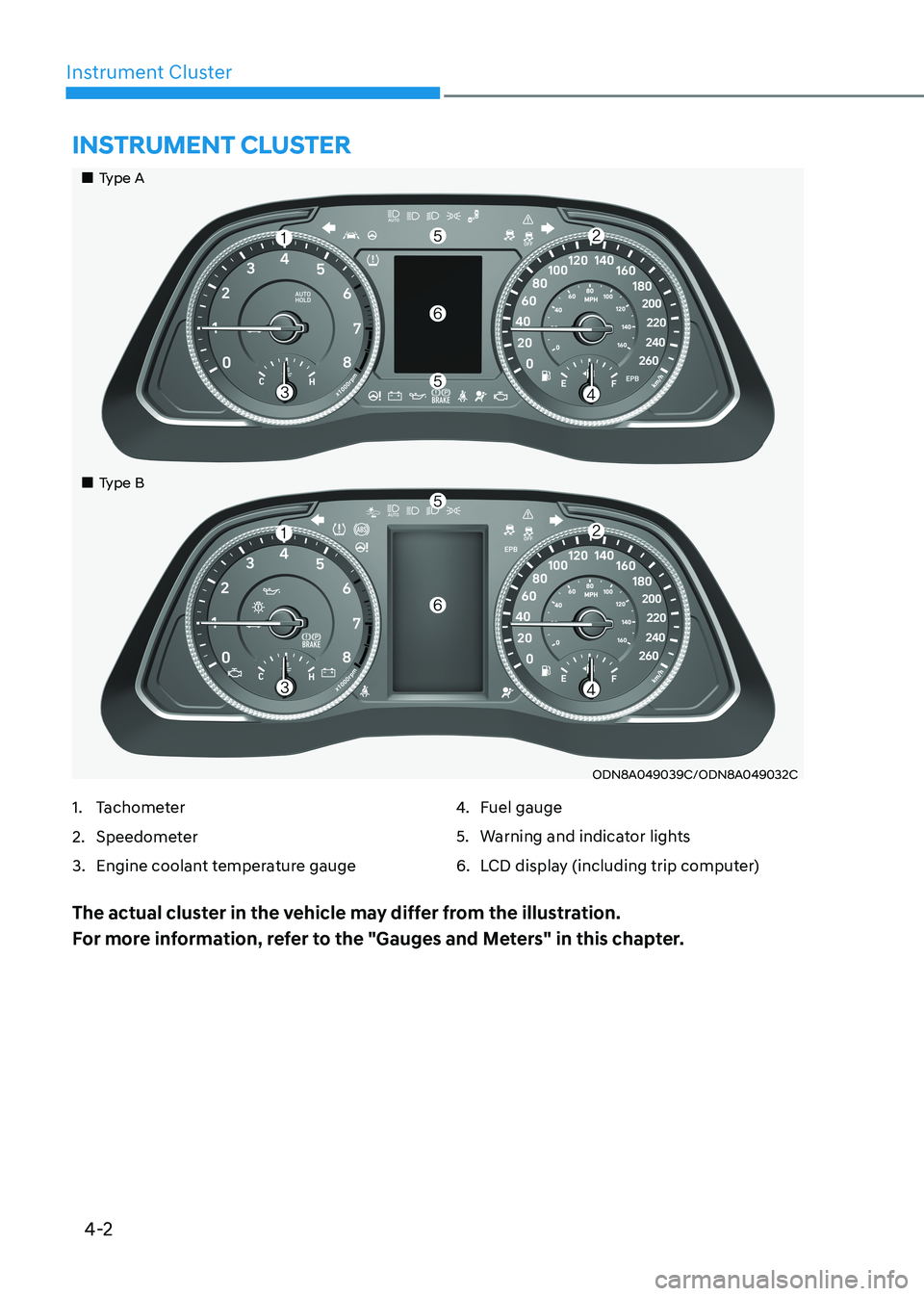
4-2
Instrument Cluster
ODN8A049039C/ODN8A049032C
Instrument Cluster
1. Tachometer
2. Speedometer
3. Engine coolant temperature gauge4.
Fuel gauge
5. Warning and indicator lights
6. LCD display (including trip computer)
The actual cluster in the vehicle may differ from the illustration.
For more information, refer to the "Gauges and Meters" in this chapter.
„„Type A
„
„Type B
Page 89 of 555
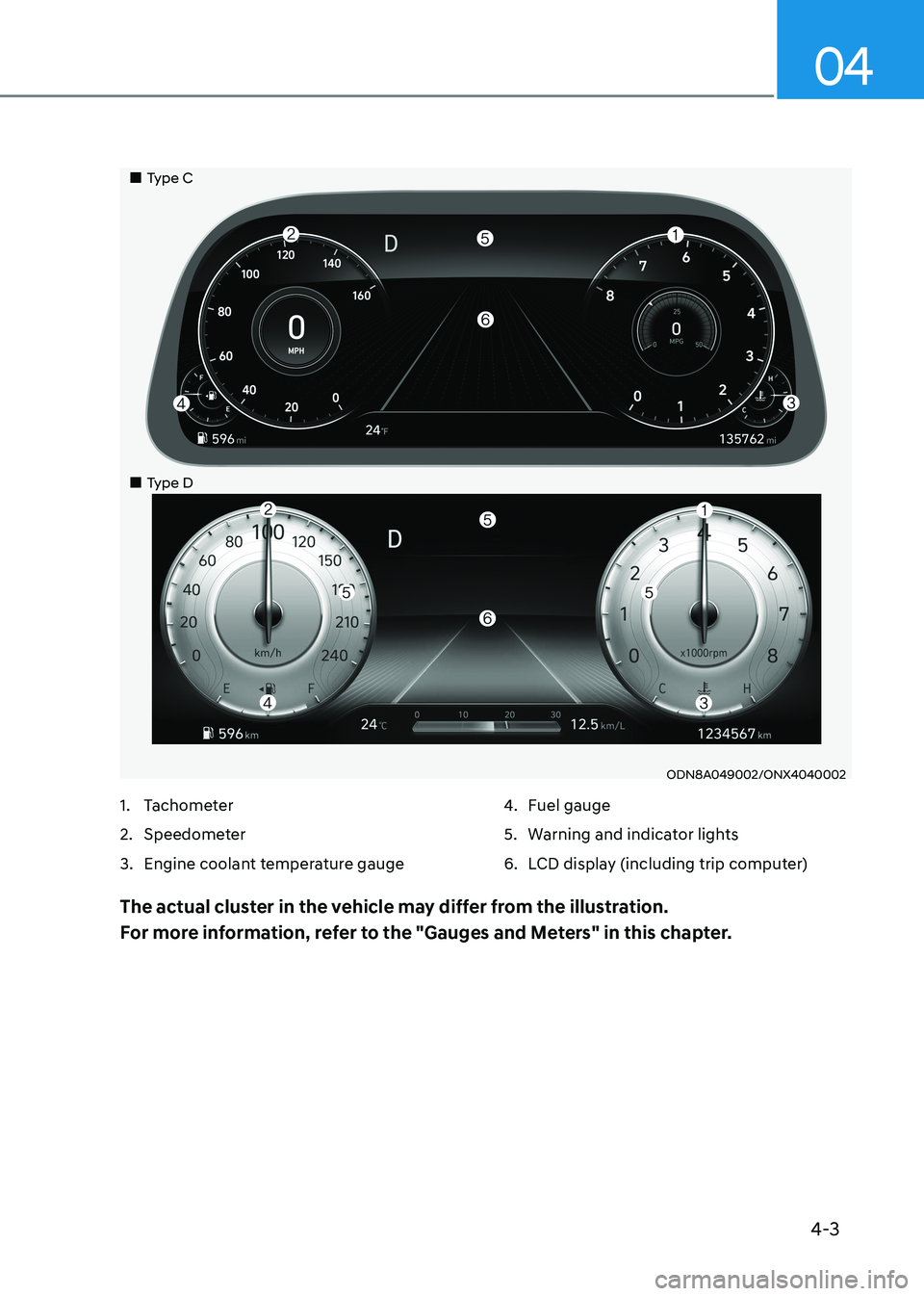
4-3
04
ODN8A049002/ONX4040002
1. Tachometer
2. Speedometer
3. Engine coolant temperature gauge 4.
Fuel gauge
5. Warning and indicator lights
6. LCD display (including trip computer)
The actual cluster in the vehicle may differ from the illustration.
For more information, refer to the "Gauges and Meters" in this chapter.
„„Type C
„
„Type D
Page 91 of 555
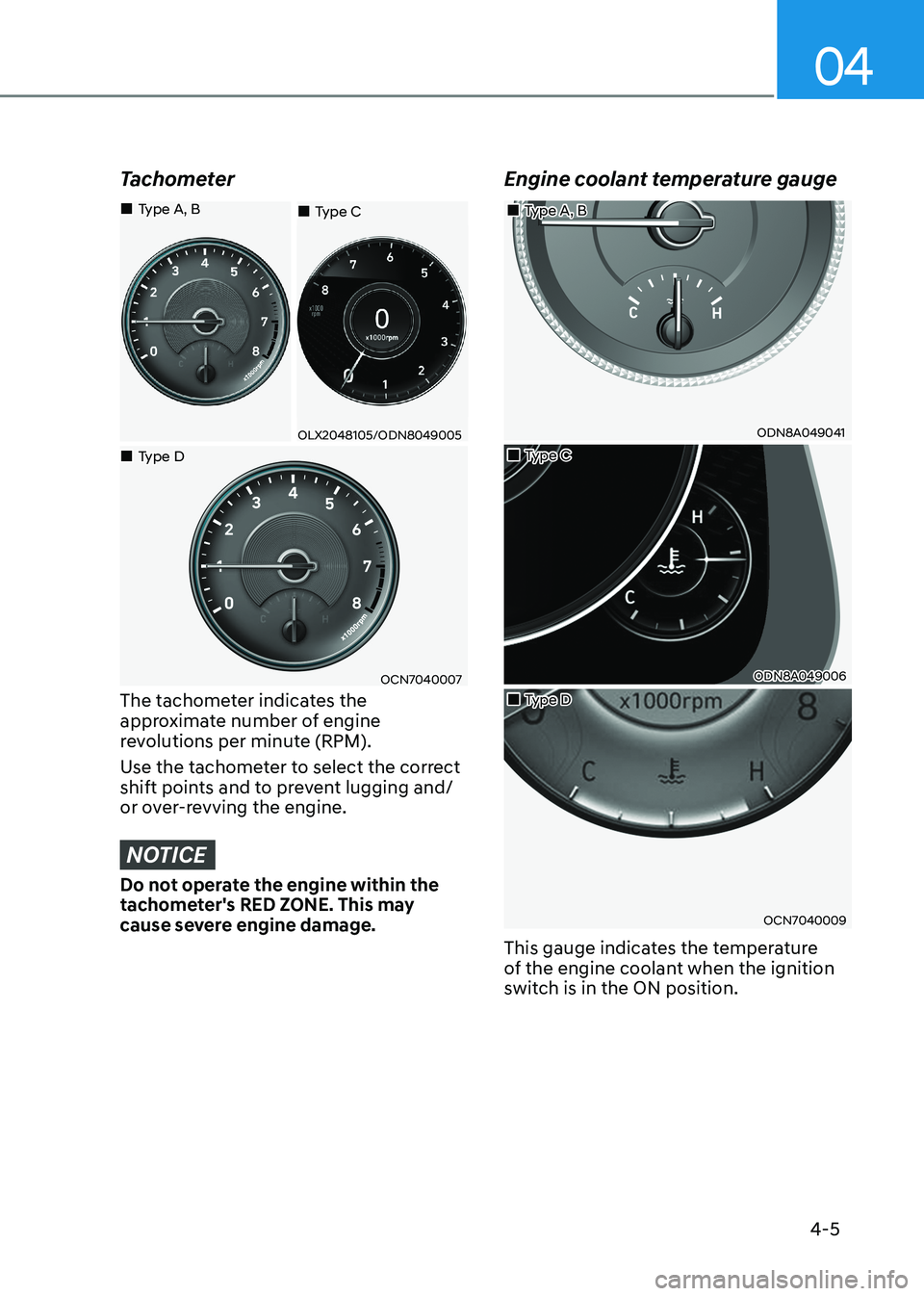
04
4-5
Tachometer
„„Type C
„
„Type D
OLX2048105/ODN8049005
OCN7040007
„
„Type A, B
The tachometer indicates the
approximate number of engine
revolutions per minute (RPM).
Use the tachometer to select the correct
shift points and to prevent lugging and/
or over-revving the engine.
NOTICE
Do not operate the engine within the
tachometer's RED ZONE. This may
cause severe engine damage. Engine coolant temperature gauge
„„Type A, B
ODN8A049041
„„Type C
ODN8A049006
„„Type D
OCN7040009
This gauge indicates the temperature
of the engine coolant when the ignition
switch is in the ON position.
Page 92 of 555
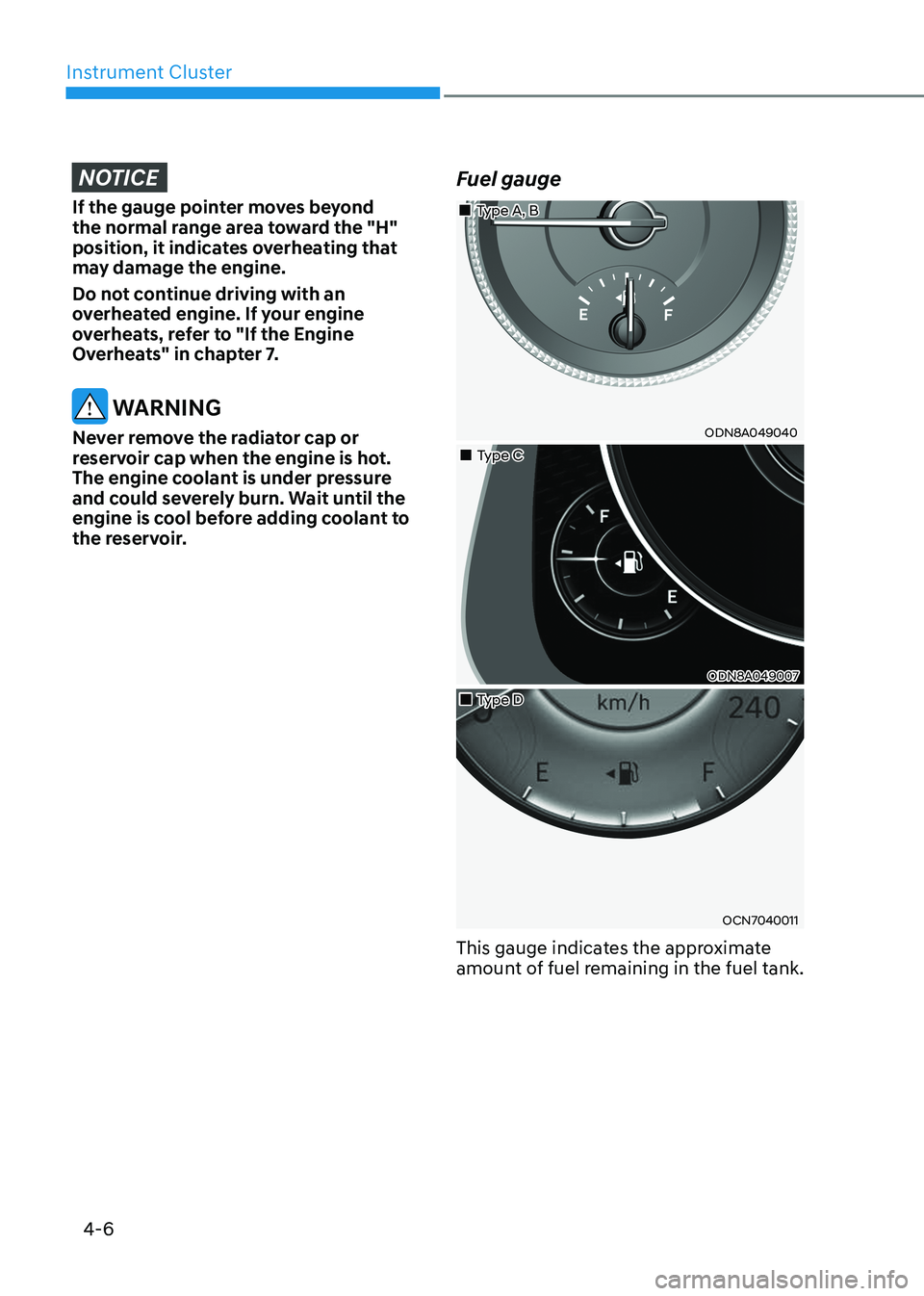
Instrument Cluster
4-6
NOTICE
If the gauge pointer moves beyond
the normal range area toward the "H"
position, it indicates overheating that
may damage the engine.
Do not continue driving with an
overheated engine. If your engine
overheats, refer to "If the Engine
Overheats" in chapter 7.
WARNING
Never remove the radiator cap or
reservoir cap when the engine is hot.
The engine coolant is under pressure
and could severely burn. Wait until the
engine is cool before adding coolant to
the reservoir. Fuel gauge
„„Type A, B
ODN8A049040
„„Type C
ODN8A049007
„„Type D
OCN7040011
This gauge indicates the approximate
amount of fuel remaining in the fuel tank.
Page 439 of 555
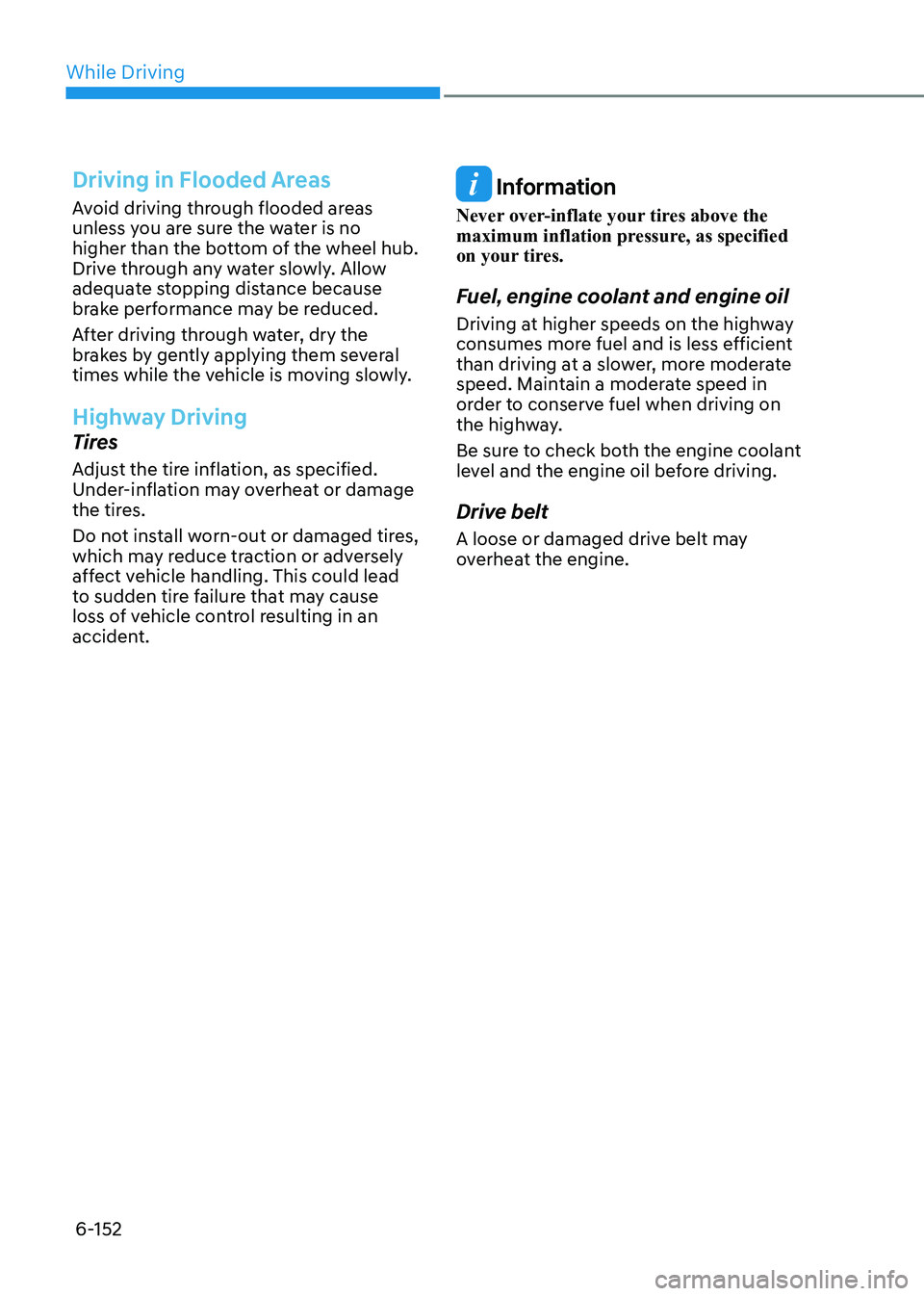
While Driving
6-152
Driving in Flooded Areas
Avoid driving through flooded areas
unless you are sure the water is no
higher than the bottom of the wheel hub.
Drive through any water slowly. Allow
adequate stopping distance because
brake performance may be reduced.
After driving through water, dry the
brakes by gently applying them several
times while the vehicle is moving slowly.
Highway Driving
Tires
Adjust the tire inflation, as specified.
Under-inflation may overheat or damage
the tires.
Do not install worn-out or damaged tires,
which may reduce traction or adversely
affect vehicle handling. This could lead
to sudden tire failure that may cause
loss of vehicle control resulting in an
accident.
Information
Never over-inflate your tires above the
maximum inflation pressure, as specified
on your tires.
Fuel, engine coolant and engine oil
Driving at higher speeds on the highway
consumes more fuel and is less efficient
than driving at a slower, more moderate
speed. Maintain a moderate speed in
order to conserve fuel when driving on
the highway.
Be sure to check both the engine coolant
level and the engine oil before driving.
Drive belt
A loose or damaged drive belt may
overheat the engine.
Page 441 of 555
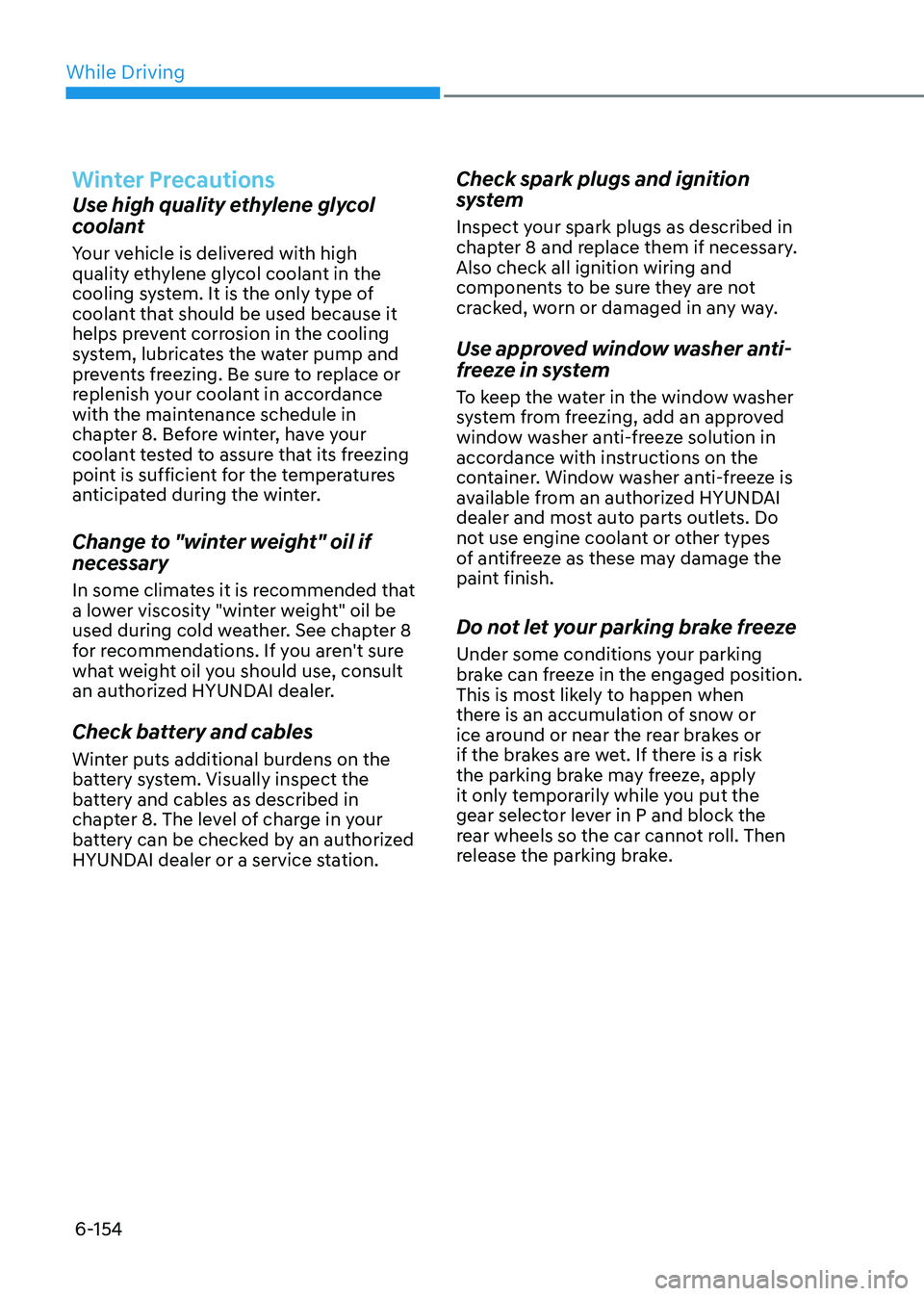
While Driving
6-154
Winter Precautions
Use high quality ethylene glycol
coolant
Your vehicle is delivered with high
quality ethylene glycol coolant in the
cooling system. It is the only type of
coolant that should be used because it
helps prevent corrosion in the cooling
system, lubricates the water pump and
prevents freezing. Be sure to replace or
replenish your coolant in accordance
with the maintenance schedule in
chapter 8. Before winter, have your
coolant tested to assure that its freezing
point is sufficient for the temperatures
anticipated during the winter.
Change to "winter weight" oil if necessary
In some climates it is recommended that
a lower viscosity "winter weight" oil be
used during cold weather. See chapter 8
for recommendations. If you aren't sure
what weight oil you should use, consult
an authorized HYUNDAI dealer.
Check battery and cables
Winter puts additional burdens on the
battery system. Visually inspect the
battery and cables as described in
chapter 8. The level of charge in your
battery can be checked by an authorized
HYUNDAI dealer or a service station.Check spark plugs and ignition
system
Inspect your spark plugs as described in
chapter 8 and replace them if necessary. Also check all ignition wiring and
components to be sure they are not
cracked, worn or damaged in any way.
Use approved window washer anti-
freeze in system
To keep the water in the window washer
system from freezing, add an approved
window washer anti-freeze solution in
accordance with instructions on the
container. Window washer anti-freeze is
available from an authorized HYUNDAI
dealer and most auto parts outlets. Do
not use engine coolant or other types
of antifreeze as these may damage the
paint finish.
Do not let your parking brake freeze
Under some conditions your parking
brake can freeze in the engaged position.
This is most likely to happen when
there is an accumulation of snow or
ice around or near the rear brakes or
if the brakes are wet. If there is a risk
the parking brake may freeze, apply
it only temporarily while you put the
gear selector lever in P and block the
rear wheels so the car cannot roll. Then
release the parking brake.
Page 454 of 555
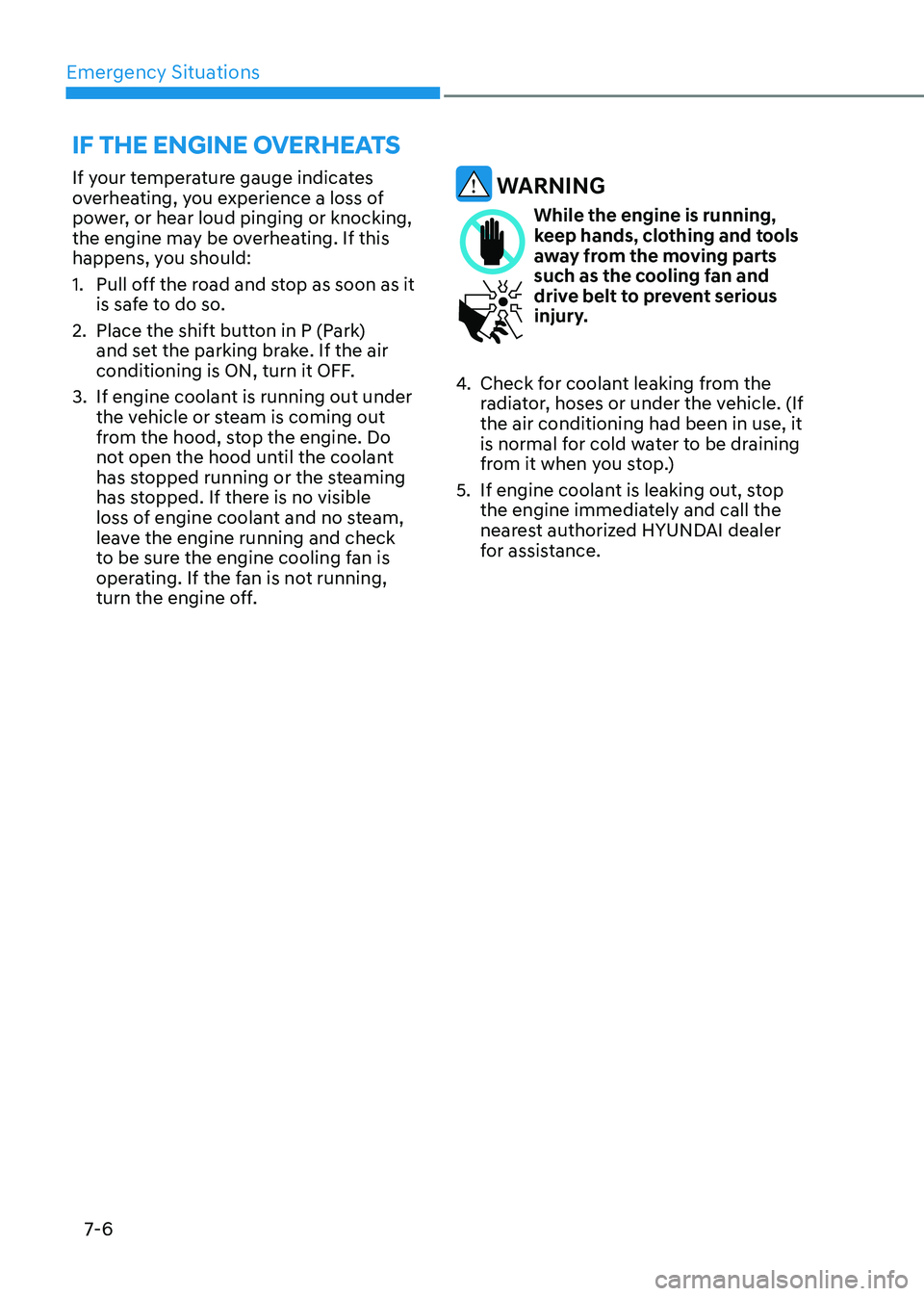
Emergency Situations
7-6
If your temperature gauge indicates
overheating, you experience a loss of
power, or hear loud pinging or knocking,
the engine may be overheating. If this
happens, you should:
1. Pull off the road and stop as soon as it
is safe to do so.
2. Place the shift button in P (Park) and set the parking brake. If the air
conditioning is ON, turn it OFF.
3. If engine coolant is running out under the vehicle or steam is coming out
from the hood, stop the engine. Do
not open the hood until the coolant
has stopped running or the steaming
has stopped. If there is no visible
loss of engine coolant and no steam,
leave the engine running and check
to be sure the engine cooling fan is
operating. If the fan is not running,
turn the engine off.
WARNING
While the engine is running,
keep hands, clothing and tools
away from the moving parts
such as the cooling fan and
drive belt to prevent serious
injury.
4. Check for coolant leaking from the
radiator, hoses or under the vehicle. (If the air conditioning had been in use, it
is normal for cold water to be draining
from it when you stop.)
5. If engine coolant is leaking out, stop the engine immediately and call the
nearest authorized HYUNDAI dealer
for assistance.
If the engIne overheats